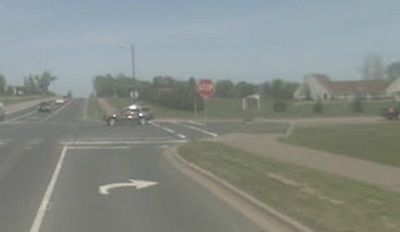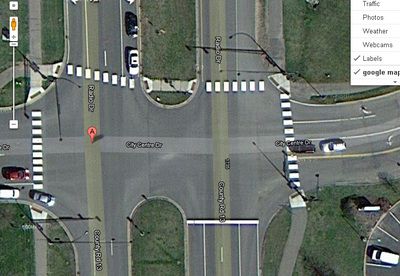Sam Newberg, at the most-excellent Streets.mn blog today, has a fascinating take on the problems with being a pedestrian on Hiawatha Avenue.
He has several recommendations for improving things, including changing the curb radius, making crosswalks a straight line from a path and giving pedestrians the same joyful “the light changes immediately” that cars approaching from side streets have — or will have once the phasing of lights is complete…
The unfortunate result is a vehicle rolling up to a red light automatically trips the actuator simply by reaching the intersection – the driver need not do anything extra. A pedestrian, however, must “apply” to cross the street (a bicycle must also apply because they aren’t heavy enough to set off the actuator) by pushing the button. I don’t know about you, but this doesn’t sit well with me. Technology does exist called proximity detectors that can “see” the presence of a pedestrian.
Many of his ideas could — and as a driver, should — be applied to any highway.
In my neighborhood — now known, thanks to a political ad, as “my little suburban world” — I make a 90-degree right turn at a four-way stop, and have to crane my neck around to make sure a bicyclist isn’t approaching the intersection on a bike path/sidewalk from 20 or more feet away, intending on declaring him/herself a pedestrian and blasting through.
Here’s the intersection (courtesy of Google Maps)
Mr. Newerg’s solution is to reconfigure right turn lanes to allow cars to approach at an angle.
… reconfiguring the right turn lane and related island could help pedestrian safety. As the image shows, a minor shift of the angle at which vehicles approach the turn and make the turn places the pedestrian crosswalk closer to the center of the driver’s peripheral vision. Doing so improves pedestrian safety. Nearly all of the intersections in question along Hiawatha have these turn lanes and islands, so the change could apply to multiple locations. Certainly eliminating right turn lanes and islands entirely would be the best solution for pedestrian safety, but the reconfiguration would be very beneficial.
That solution also highlights another problem, one for which no solution is provided: the left turn lane.
A terrible accident in April in Woodbury provides a perfect example:
At noon, the mother and her 2-year-old daughter and 4-year-old boy were struck by a vehicle at Radio Drive and Central Park Place.
“The light had just turned green, and the pedestrians were crossing and the other car was making a (left) turn…,” Police Commander Jay Alberio said.
My reaction might have been typical of many people familiar with the crosswalk, “What kind of idiot doesn’t see someone crossing the highway in a crosswalk there?”
A couple of weeks ago, I found out at the same intersection: my kind of idiot.
In making a left turn, the people on the island (it’s a divided highway) waiting to make it across the street, are in a car’s blind spot — the left frame post of the windshield. There’s no way to see them.
Newberg points out — appropriately, I think — that the pedestrian crossings on Hiawatha (and hence, elsewhere) are built to highway standards
You see, the proposed crosswalk improvements don’t do enough to improve pedestrian safety, largely because they are still beholden to highway regulations. I’m not speaking for just my own safety here, or even my kids. Hundreds of people cross each day at all of these streets, and if we are to spend public dollars to improve the safety of these crossings, we must insist they are done in a way that actually maximizes public safety. Continuing to bow to state highway regulations in an urban setting is not acceptable.
And that leads to my suggestion to ad to Newberg’s. When someone has a “walk” light, nobody moves. Period. There isn’t a green light for drivers, with the assumption that they will see — let alone, yield to the pedestrian, crossing where they want to take a lefthand turn. They get a red light — everyone gets a red light — until the pedestrian is safely across the street.
Is that too simple?


